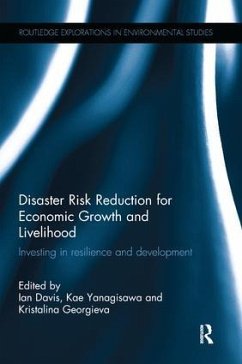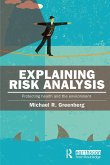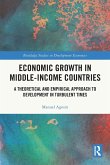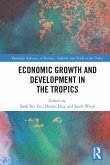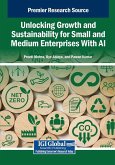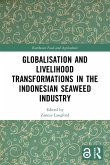Disaster Risk Reduction for Economic Growth and Livelihood
Investing in Resilience and Development
Herausgeber: Davis, Ian; Georgieva, Kristalina; Yanagisawa, Kae
Disaster Risk Reduction for Economic Growth and Livelihood
Investing in Resilience and Development
Herausgeber: Davis, Ian; Georgieva, Kristalina; Yanagisawa, Kae
- Broschiertes Buch
- Merkliste
- Auf die Merkliste
- Bewerten Bewerten
- Teilen
- Produkt teilen
- Produkterinnerung
- Produkterinnerung
This book addresses how to move towards sustainable development and enhanced resilience against natural disasters. Stressing the economic aspects of disasters, the book proposes both mitigation and adaptation measures and how they can be applied to minimize the impacts of disasters in a variety of situations. With this focus, the book starts with a call for more investment in mitigating the impacts of natural hazards, goes on to propose additional adaptive measures against growing uncertainties, and proceeds to present enablers for making effective environmental and economic policies.
Andere Kunden interessierten sich auch für
![Energy and Economic Growth Energy and Economic Growth]() Timothy J. FoxonEnergy and Economic Growth56,99 €
Timothy J. FoxonEnergy and Economic Growth56,99 €![Explaining Risk Analysis Explaining Risk Analysis]() Michael GreenbergExplaining Risk Analysis67,99 €
Michael GreenbergExplaining Risk Analysis67,99 €![Economic Growth in Middle-Income Countries Economic Growth in Middle-Income Countries]() Manuel AgosinEconomic Growth in Middle-Income Countries58,99 €
Manuel AgosinEconomic Growth in Middle-Income Countries58,99 €![Economic Growth and Development in the Tropics Economic Growth and Development in the Tropics]() Economic Growth and Development in the Tropics58,99 €
Economic Growth and Development in the Tropics58,99 €![Development and Economic Growth in India Development and Economic Growth in India]() Biswa Swarup MisraDevelopment and Economic Growth in India55,99 €
Biswa Swarup MisraDevelopment and Economic Growth in India55,99 €![Unlocking Growth and Sustainability for Small and Medium Enterprises With AI Unlocking Growth and Sustainability for Small and Medium Enterprises With AI]() Unlocking Growth and Sustainability for Small and Medium Enterprises With AI183,99 €
Unlocking Growth and Sustainability for Small and Medium Enterprises With AI183,99 €![Globalisation and Livelihood Transformations in the Indonesian Seaweed Industry Globalisation and Livelihood Transformations in the Indonesian Seaweed Industry]() Globalisation and Livelihood Transformations in the Indonesian Seaweed Industry58,99 €
Globalisation and Livelihood Transformations in the Indonesian Seaweed Industry58,99 €-
-
-
This book addresses how to move towards sustainable development and enhanced resilience against natural disasters. Stressing the economic aspects of disasters, the book proposes both mitigation and adaptation measures and how they can be applied to minimize the impacts of disasters in a variety of situations. With this focus, the book starts with a call for more investment in mitigating the impacts of natural hazards, goes on to propose additional adaptive measures against growing uncertainties, and proceeds to present enablers for making effective environmental and economic policies.
Produktdetails
- Produktdetails
- Verlag: Routledge
- Seitenzahl: 312
- Erscheinungstermin: 1. Februar 2017
- Englisch
- Abmessung: 234mm x 156mm x 17mm
- Gewicht: 477g
- ISBN-13: 9781138700307
- ISBN-10: 1138700304
- Artikelnr.: 57040405
- Herstellerkennzeichnung
- Libri GmbH
- Europaallee 1
- 36244 Bad Hersfeld
- gpsr@libri.de
- Verlag: Routledge
- Seitenzahl: 312
- Erscheinungstermin: 1. Februar 2017
- Englisch
- Abmessung: 234mm x 156mm x 17mm
- Gewicht: 477g
- ISBN-13: 9781138700307
- ISBN-10: 1138700304
- Artikelnr.: 57040405
- Herstellerkennzeichnung
- Libri GmbH
- Europaallee 1
- 36244 Bad Hersfeld
- gpsr@libri.de
Ian Davis, an architect, is a Visiting Professor in Disaster Risk Management in Copenhagen, Kyoto, Lund and Oxford Brookes Universities. He works in Disaster Risk Reduction and Recovery. In 1996 he received the UN Sasakawa Award for his contribution to Disaster Prevention. He has been on the board of four NGO's, advised Governments/ UN Agencies and is author or editor of 17 books. Kae Yanagisawa is Vice President of Japan International Cooperation Agency. She has a long-term career in international development at JICA and UNDP. She gained knowledge and experience in disaster risk reduction while she was leading the disaster relief operations of JICA. She is a Visiting Professor in development cooperation at Meiji University. Kristalina Georgieva is Vice President of the European Commission. From 2010 to 2014, she was the European Commissioner for International Cooperation, Humanitarian Aid and Crisis Response. Before joining the European Commission, she held various positions at the World Bank including Director for Sustainable Development and Vice President and Corporate Secretary. In October 2014, she was recognized as a Champion of Disaster Risk Reduction by the secretariat of International Strategy for Disaster Reduction. .
Forewords Preface Introduction Part 1: Resilience ifor sustainable
development in a changing environment 1. Building resilience to disasters
and climate change in the age of urbanization 2. Climate change and
disaster risk reduction: Adaptation to uncertainties of changing climate
3. From drought to resilience Part 2: Building awareness for disaster risk
reduction 4. Effective planning for disaster risk reduction 5. Economic
analysis of investment in DDR measures 6. Institutionalizing and sharing
the culture of prevention: The Japanese experience Part 3: Achieving build
back better in recovery and reconstruction 7. Recovery and reconstruction:
An opportunity for sustainable growth through "Build Back Better" 8.
Lessons from promoting "Build Back Better" in the post-tsunami recovery of
Aceh Part 4: Increasing the roles of stakeholders 9. Community empowerment
and good governance: The way forward for DRM in developing countries 10.
The role of the private sector in disaster risk management following
catastrophic events 11. Disaster risk governance and the principles of good
governance Part 5: Tools and technologies for disaster risk reduction 12.
National disaster databases: An essential foundation for disaster risk
reduction policies and disaster-realted sustainable development goals and
targets 13. Disaster intelligence: Using geospatial technology to improve
resilience in developing countries
development in a changing environment 1. Building resilience to disasters
and climate change in the age of urbanization 2. Climate change and
disaster risk reduction: Adaptation to uncertainties of changing climate
3. From drought to resilience Part 2: Building awareness for disaster risk
reduction 4. Effective planning for disaster risk reduction 5. Economic
analysis of investment in DDR measures 6. Institutionalizing and sharing
the culture of prevention: The Japanese experience Part 3: Achieving build
back better in recovery and reconstruction 7. Recovery and reconstruction:
An opportunity for sustainable growth through "Build Back Better" 8.
Lessons from promoting "Build Back Better" in the post-tsunami recovery of
Aceh Part 4: Increasing the roles of stakeholders 9. Community empowerment
and good governance: The way forward for DRM in developing countries 10.
The role of the private sector in disaster risk management following
catastrophic events 11. Disaster risk governance and the principles of good
governance Part 5: Tools and technologies for disaster risk reduction 12.
National disaster databases: An essential foundation for disaster risk
reduction policies and disaster-realted sustainable development goals and
targets 13. Disaster intelligence: Using geospatial technology to improve
resilience in developing countries
Forewords Preface Introduction Part 1: Resilience ifor sustainable
development in a changing environment 1. Building resilience to disasters
and climate change in the age of urbanization 2. Climate change and
disaster risk reduction: Adaptation to uncertainties of changing climate
3. From drought to resilience Part 2: Building awareness for disaster risk
reduction 4. Effective planning for disaster risk reduction 5. Economic
analysis of investment in DDR measures 6. Institutionalizing and sharing
the culture of prevention: The Japanese experience Part 3: Achieving build
back better in recovery and reconstruction 7. Recovery and reconstruction:
An opportunity for sustainable growth through "Build Back Better" 8.
Lessons from promoting "Build Back Better" in the post-tsunami recovery of
Aceh Part 4: Increasing the roles of stakeholders 9. Community empowerment
and good governance: The way forward for DRM in developing countries 10.
The role of the private sector in disaster risk management following
catastrophic events 11. Disaster risk governance and the principles of good
governance Part 5: Tools and technologies for disaster risk reduction 12.
National disaster databases: An essential foundation for disaster risk
reduction policies and disaster-realted sustainable development goals and
targets 13. Disaster intelligence: Using geospatial technology to improve
resilience in developing countries
development in a changing environment 1. Building resilience to disasters
and climate change in the age of urbanization 2. Climate change and
disaster risk reduction: Adaptation to uncertainties of changing climate
3. From drought to resilience Part 2: Building awareness for disaster risk
reduction 4. Effective planning for disaster risk reduction 5. Economic
analysis of investment in DDR measures 6. Institutionalizing and sharing
the culture of prevention: The Japanese experience Part 3: Achieving build
back better in recovery and reconstruction 7. Recovery and reconstruction:
An opportunity for sustainable growth through "Build Back Better" 8.
Lessons from promoting "Build Back Better" in the post-tsunami recovery of
Aceh Part 4: Increasing the roles of stakeholders 9. Community empowerment
and good governance: The way forward for DRM in developing countries 10.
The role of the private sector in disaster risk management following
catastrophic events 11. Disaster risk governance and the principles of good
governance Part 5: Tools and technologies for disaster risk reduction 12.
National disaster databases: An essential foundation for disaster risk
reduction policies and disaster-realted sustainable development goals and
targets 13. Disaster intelligence: Using geospatial technology to improve
resilience in developing countries

